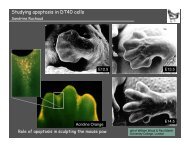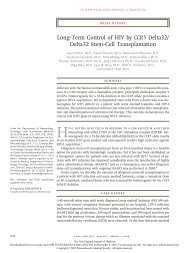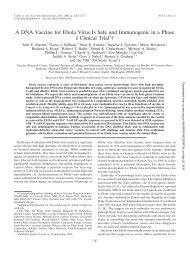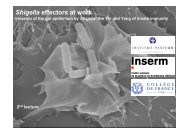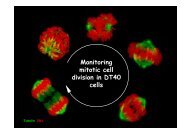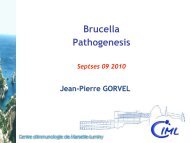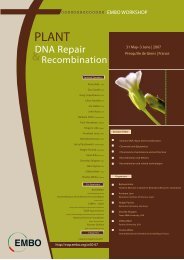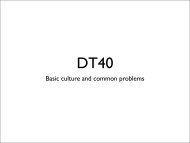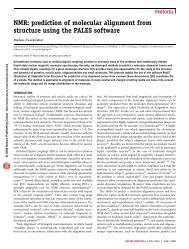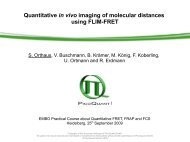You also want an ePaper? Increase the reach of your titles
YUMPU automatically turns print PDFs into web optimized ePapers that Google loves.
Residual dipolar couplings<br />
NMR workshop, Rosario November 2008<br />
Markus Zweckstetter<br />
Department for NMR-based Structural Biology,<br />
Göttingen, Germany<br />
15 N<br />
Max Planck Institute<br />
For Biophysical Chemistry<br />
1 H<br />
1<br />
B 0
NMR workshop, Rosario November 2008<br />
Background material<br />
Saupe A, Englert G (1963) Phys. Rev. Lett. 11: 462-464<br />
BothnerBy AA. (1996) In Grant DM, Harris RK (eds.), Encyclopedia of Nuclear Magnetic Resonance.<br />
Wiley, Chichester: pp. 2932-2938<br />
Tjandra N, Bax A (1997) Direct measurement of distances and angles in biomolecules by NMR in a<br />
dilute liquid crystalline medium. Science 278: 1111-1114<br />
Bax A, Kontaxis G, Tjandra N. (2001) Dipolar couplings in macromolecular structure determination. In<br />
Nuclear Magnetic Resonance of Biological Macromolecules, Pt B, Vol. 339, pp. 127-174<br />
Prestegard JH, Al-Hashimi HM, Tolman JR (2000) NMR structures of biomolecules using field<br />
oriented media and residual dipolar couplings. Q. Rev. Biophys. 33: 371-424<br />
Kramer F, Deshmukh MV, Kessler H, Glaser SJ (2004) Residual dipolar coupling constants: An<br />
elementary derivation of key equations. Concepts Magn. Reson. Part A 21A: 10-21<br />
2
NOE/ROE~1/r<br />
(NOESY, ROESY)<br />
N<br />
H N<br />
φ<br />
H α k<br />
C α k<br />
R<br />
C'<br />
ψ ω<br />
O<br />
Distance Restraints<br />
Bacteria<br />
13C,15N-Source<br />
NMR workshop, Rosario November 2008<br />
N<br />
H k+1<br />
Nk+1<br />
NMR structure determination<br />
J<br />
ω<br />
J − Coupling<br />
(E.COSY, DQ/ZQ, FIDS, quant.J)<br />
N<br />
H N<br />
Η α k<br />
C α k<br />
R<br />
C'<br />
φ ψ ω<br />
O<br />
Dihedral Restraints<br />
Sample<br />
N<br />
Ηk+1<br />
Nk+1<br />
Multi-D-NMR<br />
Structure Calculation<br />
(Simulated Annealing, Distance Geometry,<br />
Molecular Dynamics)<br />
N<br />
H N<br />
Assignment<br />
Γ c NH,CH<br />
Cross Correlated Relaxation<br />
φ<br />
H α k<br />
C α k<br />
R<br />
ω<br />
θ<br />
C'<br />
ψ ω<br />
O<br />
1) Dipole-Dipole<br />
2) Dipole-CSA<br />
3) CSA-CSA<br />
N<br />
H k+1<br />
Nk+1<br />
Projection Restraints<br />
1) Residual Dipolar Couplings<br />
2) N-H Relaxation Rates<br />
R<br />
H N<br />
N<br />
φ ψ<br />
C α k<br />
Η α k<br />
C' k+1<br />
1) Dipole-Susceptibility Tensor<br />
2) Dipole-Mass Tensor<br />
3D-Structure<br />
N<br />
H N<br />
Η α k<br />
φ<br />
C α k<br />
R<br />
C'<br />
ψ ω<br />
N<br />
Ηk+1 Nk+1<br />
Chemical Shift Restraints<br />
O<br />
3
Why do we want to use dipolar couplings in<br />
solution NMR?<br />
• all these parameters give essentially local information:<br />
distances
NMR workshop, Rosario November 2008<br />
<strong>RDC</strong>s today<br />
• Residual dipolar couplings (<strong>RDC</strong>s) can be observed in solution when a molecule<br />
is aligned with the magnetic field<br />
• When alignment can be kept sufficiently weak<br />
• NMR spectra remain simple as in isotropic solution<br />
• quantitative measurement of a wide variety of <strong>RDC</strong>s<br />
• Several dilute liquid crystalline media are now available<br />
• <strong>RDC</strong> measurements and analysis are highly efficient<br />
Residual dipolar couplings are a generally applicable tool for NMR<br />
structure determination<br />
5
NMR workshop, Rosario November 2008<br />
The dipolar coupling<br />
6
Theclassicaldipolarinteraction<br />
Nuclear spin magnetic dipole μ magnetic field<br />
NMR workshop, Rosario November 2008<br />
0 ( ) 5 ( ) ( )<br />
3<br />
μ<br />
Bμr = ⎡ − ⎤<br />
4π r<br />
⎣ μr r rr μ⎦<br />
2nd nuclear spin magnetic moment in B μ interaction energy<br />
E<br />
μ0<br />
1 ⎡ 3<br />
⎤<br />
=− B ( r12 ) μ2= 3 ⎢μ1μ2− 2 ( μ1r12 )( μ2r12 ) ⎥<br />
4π<br />
r12 ⎣ r12<br />
⎦<br />
μμ 1 2 μ1<br />
Within strong external magnetic field B 0 alignment<br />
μ r / | r | = μ cosθ<br />
1 12 12 1<br />
E<br />
μμ<br />
1 2<br />
μ<br />
1<br />
⎡<br />
⎣<br />
⎤<br />
⎦<br />
0<br />
2<br />
= μ 3 1μ2 1−3cos θ<br />
4π<br />
r12<br />
7
Theclassicaldipolarinteraction<br />
E<br />
molecular<br />
reorientation<br />
μμ<br />
1 2<br />
μ<br />
NMR workshop, Rosario November 2008<br />
1<br />
⎡ ⎤<br />
0<br />
2<br />
= μ 3 1μ2 1 3cos θ<br />
4π<br />
r ⎣ − ⎦<br />
12<br />
15 N<br />
1 H<br />
B 0<br />
isotropic<br />
π<br />
2<br />
∫ ( )<br />
0<br />
magic angle ~ 54°<br />
1− 3cos θ sinθdθ = 0<br />
8
spin I <br />
NMR workshop, Rosario November 2008<br />
Quantum mechanical picture<br />
μ = γ hI<br />
I<br />
H<br />
μ 1 ⎛ x x ⎞ γ γ hμ<br />
⎛<br />
I<br />
x x ⎞<br />
S<br />
⎝ ⎠ ⎝ ⎠<br />
3 3<br />
0 i j I S 0<br />
i j<br />
D =− 3∑μ1i⎜3 − δij⎟μ2 j =− 3<br />
3 ∑ i⎜ −δij⎟<br />
j<br />
4π r i, j= 1 r r 4πr<br />
i, j=<br />
1 r r<br />
2<br />
z<br />
IS z z :3 −1<br />
2<br />
r<br />
xz<br />
IS x z + IS z x :3 2<br />
r<br />
yz<br />
IS y z + IS z y :3 2<br />
r<br />
xy<br />
IS x y + IS y x :3 2<br />
r<br />
IS<br />
x x<br />
IS<br />
y y<br />
2<br />
x ⎫<br />
:3 −1 2<br />
r ⎪⎬⎪<br />
2<br />
y<br />
:3 −1 2<br />
r ⎪⎭<br />
2 2 2 2 2 2 2 2 2<br />
3x + 3y −2x −2y −2z − 2z + x + y ⎛3z ⎞1<br />
IS x x + IS y y :3 = − 1<br />
2 2 2<br />
2r 2r ⎜ −<br />
r<br />
⎟<br />
⎝ ⎠2<br />
9
NMR workshop, Rosario November 2008<br />
Quantum mechanical picture<br />
⎧ 2<br />
⎫<br />
⎪⎡ 1<br />
⎤⎛<br />
z ⎞<br />
IS z z − ( IS x x + IS y y)<br />
3 − 1 + ⎪<br />
⎪⎢ ⎜ 2 ⎟<br />
⎣ 2<br />
⎥<br />
⎦⎝ r ⎠<br />
⎪<br />
⎪ ⎪<br />
γγ I Shμ0⎪⎡<br />
xz yz ⎤ ⎪<br />
HD =− 3 ⎨ ( IxSz IzSx) 3 2 ( IySz IzSy) 3 2<br />
4π<br />
r ⎢<br />
+ + +<br />
r r ⎥<br />
+ ⎬<br />
⎪⎣ ⎦ ⎪<br />
⎪ 2 2<br />
⎡ xy<br />
3(<br />
x − y ) ⎤⎪<br />
⎪⎢( IS x y + IS y x) 3 + 2 ( IS x x + IS y y)<br />
⎥⎪<br />
2<br />
⎪⎢r 2r<br />
⎥⎪<br />
⎩⎣⎦⎭ spherical coordinates<br />
D<br />
x y z<br />
= sinθ cos φ; = sinθsin φ; = cosθ<br />
r r r<br />
m m −m<br />
∑( 1 ) 2 ( θφ , ) 2<br />
1<br />
H = − F T<br />
m<br />
coordinates spin operators<br />
where<br />
γγ hμ<br />
⎛24π ⎞<br />
F =− ⎜ ⎟ Y<br />
4πr⎝ 5 ⎠<br />
m I S 0<br />
2<br />
m<br />
2 3<br />
2<br />
10
NMR workshop, Rosario November 2008<br />
Spherical harmonics<br />
m<br />
component ( , )<br />
m = 0 ⎛ 5 ⎞21<br />
2<br />
⎜ ⎟ ( 3cos θ −1)<br />
⎝4π⎠ 2<br />
1<br />
m =± 1 ⎛15 ⎞2<br />
− ⎜ ⎟ sinθ cosθ exp(<br />
± iφ)<br />
⎝8π⎠ 1<br />
m =± 2 ⎛15 ⎞21<br />
2<br />
⎜ ⎟ sin θ exp( ± i2φ)<br />
⎝2π⎠ 4<br />
m<br />
Y2 θφ T2 −<br />
1<br />
⎛ 1 ⎞⎡ 1<br />
⎤<br />
⎜ ⎟⎢<br />
IS z z − ( IS x x + IS y y)<br />
6 ⎣ 2<br />
⎥<br />
⎝ ⎠<br />
⎦<br />
1<br />
± +<br />
2<br />
[ IS IS]<br />
z ± ± z<br />
1<br />
2 IS<br />
± ±<br />
+ ( x y ) = + I− = ( Ix−iIy) I I iI<br />
( )<br />
exp iφ= cosφ +<br />
isinφ<br />
11
NMR workshop, Rosario November 2008<br />
Secular approximation<br />
γγ I Shμ0<br />
2 ⎡ 1<br />
⎤<br />
H D =− 3 ( 3cos θ −1) IS z z − ( IS + − + IS − + )<br />
4πr⎢ ⎣ 4<br />
⎥<br />
⎦<br />
heteronuclear case<br />
γ γ hμ<br />
2<br />
H ( θ ) I S<br />
4π<br />
r<br />
I S 0<br />
D =− 3cos −1<br />
3 z z<br />
γ Iγ Shμ0<br />
3<br />
4π<br />
r<br />
1<br />
2<br />
( )<br />
IS + IS = IS+ IS<br />
+ − − +<br />
x x y y<br />
r = 1.04 1 D(N,H) = 21.7 kHz<br />
12
molecular tumbling/internal motion <br />
NMR workshop, Rosario November 2008<br />
PQ γ γ hμ<br />
2<br />
D =− ∫ P( β , γ) F ( θ, φ) d( cosβ)<br />
dγ<br />
P Q 0 0<br />
3<br />
4πr4π 2<br />
PQ<br />
D<br />
γ γ hμ<br />
1<br />
3cos 1<br />
4πr2 ( θ )<br />
P Q 0 2<br />
=− −<br />
3<br />
sampled orientations<br />
13
Molecular alignment and <strong>RDC</strong>s<br />
NMR workshop, Rosario November 2008<br />
14
NMR workshop, Rosario November 2008<br />
Molecular alignment and <strong>RDC</strong>s<br />
( ) ( () () () ) 2<br />
3 1<br />
P2 cosθ = cos βx t cosα x + cos βy<br />
t cosαy + cos βz<br />
t cosαz<br />
−<br />
2 2<br />
P<br />
2<br />
( ) ( )<br />
Ci t = cos βi<br />
t and<br />
ci = cosα<br />
i<br />
( cosθ<br />
)<br />
2 2<br />
2<br />
⎡ 2 2 2<br />
3 Cx() t cx + Cy() t cy + Cz() t cz<br />
+<br />
⎤<br />
1<br />
= ⎢ ⎥−<br />
2⎢2 C () () 2 () () 2 () () 2<br />
x t Cy t cxcy Cx t Cz t cxcz Cy t Cz t cyc ⎥<br />
⎣<br />
+ +<br />
z⎦<br />
B 0<br />
θ<br />
β x (t)<br />
βz (t)<br />
βy (t)<br />
P2(<br />
cosθ ) =<br />
3 T<br />
2<br />
( br 0 0)<br />
−1<br />
2<br />
⎧ ⎛<br />
⎪ ⎜<br />
3⎪ 0 0 0 ⎜<br />
= ⎨( rx , ry , rz )<br />
2 ⎜<br />
⎪ ⎜<br />
⎪ ⎜<br />
⎩ ⎝<br />
2<br />
Cx() t<br />
Cx() t Cy() t<br />
Cx() t Cz() t<br />
Cx() t Cy() t<br />
2<br />
Cy() t<br />
Cy() t Cz() t<br />
Cx() t Cz() t ⎞ ⎫<br />
0<br />
⎟⎜⎛r⎞ x ⎪<br />
⎟ 0 ⎟⎪<br />
1<br />
Cy() t Cz() t<br />
⎟⎜ry<br />
⎟⎬−<br />
0 2<br />
2 ⎟⎜r⎟⎪ z<br />
Cz() t ⎟⎝<br />
⎠⎪<br />
⎠ ⎭<br />
α x<br />
x<br />
P<br />
z<br />
α z<br />
Q<br />
α y<br />
15<br />
orientational probability distribution<br />
y
NMR workshop, Rosario November 2008<br />
Molecular alignment and <strong>RDC</strong>s<br />
( ) ( ) ( ) ( )<br />
S = 3/2 cosβ t cosβ t − 1/2δ = 3/2 C t C t −1/2δ<br />
ij i j ij i j ij<br />
2 2 2<br />
x + y + z = 1 CC i j = CjCi C C C<br />
P2( cosθ ) = ∑ Sij<br />
cosαicosα j<br />
{ }<br />
i, j= x, y, z<br />
( θPQ = αz; cz= cos θPQ; cx= sinθPQ cos φPQ; cy=<br />
sinθ PQ sinφPQ<br />
)<br />
S is real, traceless, symmetric<br />
5 independent elements<br />
principal alignment frame, i.e. diagonalization of S S d<br />
3<br />
( ) { }<br />
α , α , α = ⎡ + + ⎤−1<br />
PQ PQ<br />
2 2 2 2 2 2<br />
x y z max x x y y z z<br />
D D C c C c C c<br />
2 ⎢⎣ ⎥⎦<br />
2<br />
i 1/3 ij<br />
C A<br />
P<br />
x; S xx d<br />
φ PQ<br />
z; S zz d<br />
PQ PQ 2 2 2 2 2<br />
= + ( )<br />
θ PQ<br />
Q<br />
y; S yy d<br />
3<br />
D αx, αy, αz = D ⎡ max cos θPQAzz + sin θPQ cos φPQ Axx+ sin θPQsin φPQ<br />
A ⎤ yy<br />
2 ⎣ ⎦<br />
PQ 3 PQ ⎡ 1 2<br />
⎤<br />
D ( θPQ, φPQ) = Dmax P2( cosθPQ ) Azz sin θPQcos 2φPQ<br />
( Axx 16Ayy<br />
)<br />
2 ⎢<br />
+ −<br />
⎣ 2<br />
⎥<br />
⎦
γ PγQhμ PQ<br />
⎡ 3<br />
⎤<br />
D ( θ φ ) S<br />
⎢( θ ) R θ φ<br />
⎣<br />
⎥<br />
⎦<br />
NMR workshop, Rosario November 2008<br />
A a =3/2A zz =S zz d , Ar =(A xx -A yy )=2/3 (S xx d -Syy d )<br />
PQ PQ ⎡ 3 2<br />
⎤<br />
D ( θPQ, φPQ) = Dmax ⎢<br />
P2( cosθPQ) Aa + Arsin<br />
θPQcos2φPQ ⎣ 4<br />
⎥<br />
⎦<br />
PQ PQ ⎡ 2 3 2<br />
⎤<br />
D ( θPQ, φPQ ) = Da⎢( 3cos θPQ − 1) + Rsin<br />
θPQcos2φPQ ⎣ 2<br />
⎥<br />
⎦<br />
0 2 2<br />
PQ, PQ =− LS 3cos 1 sin cos2<br />
2 3<br />
PQ − +<br />
PQ PQ<br />
4π<br />
r<br />
2<br />
PQ<br />
D a PQ = ½ D PQ max A a : magnitude of alignment tensor (A a =10 -3 D a NH ~ 10 Hz)<br />
R = A a /A r : rhombicity of alignment tensor; R ∈ [0; 2/3]<br />
use only a very slight orientational preference ("partial alignment"), i.e.,<br />
only ca. 1 out of 1000 solute molecules<br />
Generalized degree of order (GDO):<br />
Euclidean norm ϑ = ( 2 / 3 4 /5 π ∑ i,j S ij 2 ) 1/2<br />
17
How to Get Alignment<br />
NMR workshop, Rosario November 2008<br />
18
NMR workshop, Rosario November 2008<br />
Partial Alignment<br />
• dipolar couplings are LARGE in solids (~22 kHz for 1 D HN !), but<br />
• fortunately average out for isotropically fast tumbling (solution NMR)<br />
⇒ full dipolar couplings are not desirable in high-resolution NMR<br />
Can we get orientational information WITHOUT messing up our nice NMR spectra ?<br />
YES!<br />
• use only a very slight orientational preference ("partial alignment"), i.e.,<br />
only ca. 1 out of 1000 solute molecules<br />
result: dipolar coupling from the (0.1%) non-isotropic fraction is scaled down to<br />
residual dipolar couplings (<strong>RDC</strong>s) of ± 20 Hz max.! (0.1% of ±20 kHz)<br />
19
Alignment – Anisotropic Tumbling<br />
To extract dipolar coupling data, the molecule must behave anisotropically!<br />
1) large magnetic susceptibility anisotropy<br />
• diamagnetic systems such as DNA (small anisotropy in each base)<br />
• metalloproteins with paramagnetic centers<br />
• lanthanide-binding tags<br />
2) anisotropic environment<br />
• oriented liquid-crystalline phase<br />
• anisotropically compresed gel<br />
NMR workshop, Rosario November 2008<br />
field-dependent alignment of molecules<br />
field-independent alignment<br />
20
Requirements<br />
NMR workshop, Rosario November 2008<br />
Alignment media<br />
• liquid crystalline at < 10% w/v order of biomolecules: ~ 0.002<br />
• aqueous<br />
• uniform anisotropy over the whole sample volume,<br />
• stable at different ionic strength, pH, temperature<br />
• not too strongly charged < 0.5 e/nm 2 ,<br />
• solute should not bind (significantly) to medium<br />
21
NMR workshop, Rosario November 2008<br />
Bicelles<br />
• Diskshaped particles made from DMPC and DHPC (q = 3:1)<br />
• concentration usually 5% (w/v)<br />
• degree of protein alignment can be “tuned” by adjusting the<br />
bicelle concentration<br />
• alignment is temperature dependent (liquid crystal > 37°C)<br />
• aligning with their normal perpendicular to the direction of the<br />
magnetic field<br />
• degree of alignment can be determined by measuring the 2H<br />
quadrupolar splitting in the HDO resonance.<br />
22
NMR workshop, Rosario November 2008<br />
Bicelles (2)<br />
• Isotropic bicelles (q ~ 0.5) for solubilization of integral<br />
membrane proteins solution-state NMR<br />
• Anisotropic bicelles for solid-state NMR and X-ray<br />
crystallography<br />
Disadvantages:<br />
• unstable in the presence of certain proteins<br />
• offers only a limited temperature and pH range<br />
23
• bicelles<br />
NMR workshop, Rosario November 2008<br />
Alignment media - Toolbox<br />
• alkyl poly(ethylene glycol) based media<br />
• filamentous phage (Pf1,fd; -0.47 e/nm 2 )<br />
• polyacrylamide gel (charged, uncharged)<br />
• cellulose crystallites<br />
• purple membrane fragments<br />
• cetylpyrimidinium-based media, ...<br />
24
Alignment of Membrane Proteins<br />
Acrylamide gels DNA nanotubes<br />
G-tetrad DNA<br />
NMR workshop, Rosario November 2008<br />
Douglas et al.<br />
PNAS, 2007<br />
Lorieau et al.<br />
JACS, 2008<br />
25
Modulation of alignment tensor<br />
NMR workshop, Rosario November 2008<br />
26
The problem: Orientational degeneracy<br />
NMR workshop, Rosario November 2008<br />
D PQ = D a PQ [(3 cos 2 θ –1) + 3/2 R sin 2 θ cos(2φ)]<br />
Ramirez & Bax<br />
JACS, 1998<br />
27
Strategies for Modulation of Alignment<br />
• Alignment media with different properties (steric/electrostatic)<br />
• Charged bicelles: doping with small charged amphiphiles to alter<br />
their charge<br />
Positive: CTAB / Negative: SDS<br />
•Chargedgels<br />
• variation of pH, ionic strength<br />
• mutation (introduction of charged residues)<br />
• paramagnetic alignment (different tags/lanthanides)<br />
NMR workshop, Rosario November 2008<br />
28
Attenuation of alignment strength by<br />
increasing the ionic strength<br />
450 mM NaCl<br />
20 mg/ml Pf1<br />
150 mM NaCl<br />
9.0 8.0<br />
7.0<br />
ppm<br />
NMR workshop, Rosario November 2008<br />
ubiquitin at 450 mM NaCl<br />
in 20 mg/ml Pf1<br />
29
Modulation of alignment tensor orientation<br />
by ionic strength changes<br />
NMR workshop, Rosario November 2008<br />
GB1<br />
30
NMR workshop, Rosario November 2008<br />
Liquid crystal theory<br />
31
NMR workshop, Rosario November 2008<br />
Liquid crystal theory<br />
Onsager (1949): concentration at which a solution undergoes a spontaneous first<br />
order phase transition from an isotropic to a chiral nematic phase<br />
25 Hz<br />
B 2 c p > c a<br />
B 2 = π D eff L 2 /4<br />
first-order transition coexistence region c p ∈ [c i , c a ]<br />
for semi-flexible rods<br />
c i = 0.3588 [(1-√x)B 2 ] -1 c a = 0.3588 [(x-√x)B 2 ] -1<br />
32
B 2 c p > c a<br />
B 2 = π D eff L 2 /4<br />
NMR workshop, Rosario November 2008<br />
Onsager theory<br />
effective increase in rod diameter<br />
D eff = D + κ -1 (ln ω + 0.7704)<br />
contact potential ω = 2π Z2 [βγx0 K1 (x0 )] -2 Q κ-1 exp(-2 x0 )<br />
contribution of the polyions to the ionic strength κ = 8πQ(cs + Γzpcp )<br />
33
NMR workshop, Rosario November 2008<br />
Liquid crystal theory<br />
density of most nematogens is higher than for the solvent<br />
average density of the nematic region is higher than for the isotropic region gravity<br />
causes it to occupy the bottom region of the sample<br />
Pf1 (12 mg/ml)<br />
0.5M<br />
B 2 c p > 4.19 and B 2 c p > 5.51<br />
34
NMR workshop, Rosario November 2008<br />
Paranematic phase of Pf1 phage<br />
For a fully nematic phase, the degree of alignment is independent of field<br />
strength above a typically very low threshold<br />
paranematic<br />
Q cc ( 2 H) = 0.886 c Pf1<br />
c Pf1 [mg/ml]<br />
• 600 MHz<br />
□ 800 MHz<br />
35
Measurement of <strong>RDC</strong>s<br />
NMR workshop, Rosario November 2008<br />
36
NMR workshop, Rosario November 2008<br />
NOESY HSQC<br />
37
Accuracy of measured splitting: ΔJ = LW/SN<br />
1 JHN [1]: IPAP-HSQC, DSSE-HSQC, 3D HNCO<br />
1 JC‘Cα [5]: 3D HNCO (CSA(C‘) ~ 500 MHz optimum)<br />
1 JC‘N & 2 J C‘HN [8.3]: 2D HSQC, 3D TROSY-HNCO<br />
1 JCαHα [0.5]: 2D J CH -modulated HSQC, (HA)CANH, HN(CO)CA<br />
1 JCH (side-chain): 2D J CH -mod. HSQC, CCH-COSY, SPITZE-HSQC<br />
1 H- 1 H: COSY, CT-COSY, HNHA, 3D SS-HMQC2 (long-range)<br />
NMR workshop, Rosario November 2008<br />
required accuracy < 5% * Da<br />
Bax, Kontaxis & Tjandra Method Enzymol. 339, 127-174, 2001;<br />
Chou & Bax JBNMR, 2001; Delaglio et al. JMR 2001; Wu & Bax, JACS, 2002;<br />
38
<strong>RDC</strong> measurement: J splitting ( 1 J HN)<br />
IPAP-HSQC<br />
Ottiger et al. JMR, 1998<br />
NMR workshop, Rosario November 2008<br />
39
<strong>RDC</strong> measurement: Quantitative J<br />
correlation ( 1 J C‘N)<br />
NMR workshop, Rosario November 2008<br />
Chou & Bax<br />
JBNMR, 2001<br />
40
Determination of a Molecular<br />
NMR workshop, Rosario November 2008<br />
Alignment Tensor<br />
41
1) <strong>RDC</strong> distribution analysis<br />
NMR workshop, Rosario November 2008<br />
Four Methods<br />
2) Back-calculation of alignment tensor<br />
3) Prediction of alignment from structure<br />
4) Prediction of alignment from structure and charge distribution<br />
42
Count<br />
1) Estimate for alignment tensor<br />
30<br />
20<br />
10<br />
D zz PQ = 2 Da PQ<br />
D yy PQ = –Da PQ (1 + 1.5 R)<br />
D xx PQ = –Da PQ (1 – 1.5 R)<br />
with D ii PQ = D PQ max S ii d no structure necessary !<br />
NMR workshop, Rosario November 2008<br />
0<br />
D<br />
A xx B<br />
D zz<br />
-40 -20 0 20<br />
D yy<br />
R<br />
0.2<br />
0.1<br />
0<br />
1d(NH) [Hz]<br />
-20 -15<br />
D aNH [Hz]<br />
-20 0 20<br />
log( L( d 1…n PQ | Da PQ , R)) = ∑i=1,..,N log (P(d i PQ ))<br />
43
2) Back-calculation of alignment tensor<br />
if well-defined structure available<br />
• singular value decomposition (SVD)<br />
very stable & with a minimum<br />
of five <strong>RDC</strong>s possible<br />
• iterative least squares procedure (Levenberg-Marquardt minimization)<br />
χ 2 = ∑ i=1,..,N [d i PQ (exp) – di PQ (calc)] 2 /(σi PQ ) 2<br />
fixing of alignment parameters (e.g. rhombic component zero due to<br />
three-fold or higher symmetry)<br />
NMR workshop, Rosario November 2008<br />
2 GLN HN 2 GLN N -8.170 1.000 1.00<br />
3 ILE HN 3 ILE N 8.271 1.000 1.00<br />
4 PHE HN 4 PHE N 10.489 1.000 1.00<br />
5 VAL HN 5 VAL N 9.871 1.000 1.00<br />
6 LYS HN 6 LYS N 9.152 1.000 1.00<br />
7 THR HN 7 THR N 3.700 1.000 1.00<br />
8 LEU HN 8 LEU N 6.461 1.000 1.00<br />
10 GLY HN 10 GLY N 7.634 1.000 1.00<br />
11 LYS HN 11 LYS N -7.528 1.000 1.00<br />
44
Evaluation of uncertainty in backcalculated<br />
alignment tensors (I)<br />
Can you trust a back-calculated alignment tensor?<br />
Monte-Carlo type approach (<strong>RDC</strong> noise)<br />
´<br />
repeat SVD calculation many times (~1000 times)<br />
each time add different Gaussian noise to experimental <strong>RDC</strong>s<br />
accept only those solutions for which all back-calculated <strong>RDC</strong>s are within<br />
a given margin of the original experimental dipolar couplings<br />
error in the data is dominated by the random measurement error in the dipolar couplings<br />
indirectly take into account uncertainties in the structure<br />
set the amplitude of the added noise two to three times higher than the measurement uncertainty<br />
NMR workshop, Rosario November 2008<br />
45
Evaluation of uncertainty in backcalculated<br />
alignment tensors (II)<br />
Structural noise Monte-Carlo type approach<br />
repeat SVD calculation many times (~1000 times)<br />
each time add different Gaussian noise to the original structure (match the<br />
RMSD between the experimental and back-calculated <strong>RDC</strong>s)<br />
spread in alignment parameters obtained for these noise-corrupted structures,<br />
when using the coupling constants calculated for the original structure (i.e.,<br />
yielding a perfect fit if no structural noise were added)<br />
NMR workshop, Rosario November 2008<br />
46
3) Prediction of alignment from structure<br />
NMR workshop, Rosario November 2008<br />
no <strong>RDC</strong>s necessary !<br />
47
NMR workshop, Rosario November 2008<br />
Computer experiment: PALES<br />
S ij =1/2 (i,j=x,y,z)<br />
S mol linear average over all non-excluded S matrices<br />
Periodic boundary conditions<br />
r < d/(2 V f ) (wall model), or r < d/(4V f ) 1/2 (cylinder)<br />
48
Shape prediction of magnitude and<br />
orientation of alignment<br />
1 DNH predicted [Hz]<br />
NMR workshop, Rosario November 2008<br />
1 DNH measured [Hz]<br />
Protein alignment in bicelles is sterically induced<br />
49
Weak alignment in Pf1 bacteriophage<br />
http://www.asla-biotech.com/asla-phage.htm<br />
NMR workshop, Rosario November 2008<br />
50
4) Prediction of alignment from structure<br />
and charge distribution<br />
B 0<br />
NMR workshop, Rosario November 2008<br />
p B = exp[ -ΔG el (r,Ω)/k B T]<br />
ΔG el (r,Ω) = ∑ i q i φ[r i (r,Ω)]<br />
S ij mol = ∫ Sij p B (r,Ω) dr dΩ / ∫ p B (r,Ω) dr dΩ<br />
steric<br />
p = 0 p = 1 p = 1<br />
51
How to calculate the electrostatic energy?<br />
• Continuum electrostatic theory (Debye and Hueckel 1923): protein embedded in<br />
a dielectric medium containing excess ions<br />
• non-linear Poisson-Boltzmann equation (Chapman 1913; Gouy 1910)<br />
• Further simplification: Protein = a particle in the external field of the liquid<br />
crystal many approximations !<br />
• protein = charges of their ionizable residues<br />
• static dielectric constant of water ε = 78.29<br />
• average surface charge of phages: -0.47 e/nm2 NMR workshop, Rosario November 2008<br />
52
elative G<br />
φ [kT/e]<br />
0.5<br />
0<br />
-2<br />
-4<br />
0<br />
NMR workshop, Rosario November 2008<br />
Electrostatic potential<br />
10 20<br />
distance from Pf1 [nm]<br />
B<br />
53
ubiquitin<br />
DinI<br />
GB3<br />
GB1<br />
DNA<br />
Experiment versus PALES prediction<br />
steric<br />
NMR workshop, Rosario November 2008<br />
electrostatic + steric<br />
Zweckstetter et al.,<br />
Biophys. J. 2004<br />
54
ubiquitin<br />
DinI<br />
GB3<br />
GB1<br />
DNA<br />
NMR workshop, Rosario November 2008<br />
Ionic strength dependence<br />
magnitude<br />
orientation<br />
55
10-20 nm<br />
Weak alignment in surfactant liquid<br />
crystalline phases<br />
3 nm<br />
PALES<br />
NMR workshop, Rosario November 2008<br />
+<br />
+ +<br />
+<br />
+<br />
+<br />
+<br />
B 0<br />
Lα<br />
56
Residual dipolar couplings in<br />
cetylpyridinium bromide/hexanol/sodium<br />
bromide<br />
NMR workshop, Rosario November 2008<br />
Zweckstetter,<br />
submitted<br />
steric and electrostatic interactions<br />
dominate weak alignment of biomolecules<br />
in polar liquid crystalline media<br />
57
Barrientos et al.,<br />
JMR 2001<br />
pH 7<br />
pH 3<br />
NMR workshop, Rosario November 2008<br />
Partial alignment at pH 3<br />
pH 3<br />
pH 7<br />
Zweckstetter, Eur. Biophys. J. 2005<br />
58
NMR workshop, Rosario November 2008<br />
PH dependence of alignment<br />
59
<strong>RDC</strong>s are a sensitive probe of protein<br />
electrostatics<br />
DinI (PDB code: 1GHH)<br />
Zweckstetter et al., Biophys. J. 2004<br />
NMR workshop, Rosario November 2008<br />
60
Charge/Shape prediction: applications<br />
• differentiation of monomeric and homodimeric states<br />
(Zweckstetter and Bax 2000)<br />
• conformational analysis of dynamic systems such as oligosaccharides<br />
(Azurmendi and Bush 2002)<br />
• refinement of nucleic acid structures<br />
(Warren and Moore, 2001)<br />
• determination of the relative orientation of protein domains<br />
(Bewley and Clore 2000)<br />
• validation of structures of protein complexes<br />
(Bewley 2001)<br />
• classify protein fold families on the basis of unassigned NMR data<br />
(Valafar and Prestegard 2003)<br />
• Probing surface electrostatics of proteins and nucleic acids,<br />
refinement of side chain orientations in proteins, …<br />
NMR workshop, Rosario November 2008<br />
61
<strong>RDC</strong>s in Structure Calculation<br />
NMR workshop, Rosario November 2008<br />
62
<strong>RDC</strong>-based refinement of structures<br />
PROBLEM:<br />
Potential energy surface is very rough many local/false minima <br />
convergence problem<br />
NMR workshop, Rosario November 2008<br />
<strong>RDC</strong>-based refinement of starting structures<br />
k dip force constant adjust such that dipolar RMS is equal to<br />
measurement error)<br />
63
NMR workshop, Rosario November 2008<br />
Crititical Points<br />
How to use the structural information obtained from molecular alignment<br />
1. In order to use the information one needs to know the direction and the size of the<br />
tensor (susceptibility, alignment, etc).<br />
2. Minimization of the deviation between the measured quantity and its calculated<br />
value from a given structure and set of tensor parameters.<br />
3. One has to be able to evaluate the outcome of the minimization.<br />
Minimization procedure<br />
1. Get a good estimate on the tensor parameters (magnitude and rhombicity).<br />
2. Define structural constraints with respect to the arbitrary tensor coordinate system.<br />
3. Turn on the force constant for a particular alignment potential such that the final<br />
RMS between the measured and calculated values reflect the experimental error.<br />
4. During the calculation the tensor orientation will be automatically determined<br />
through global minimization with respect to the current structure.<br />
5. Refine the initial estimate of the tensor parameters. This can be achieved through<br />
either grid search method or built into the minimization itself.<br />
64
Define axis system representing the<br />
alignment tensor<br />
NMR workshop, Rosario November 2008<br />
65
NMR workshop, Rosario November 2008<br />
From PALES to XPLOR<br />
rDC(NH) measured aligned - isotropic (PALES convention)<br />
(min(DC)=-16.2 Hz; max(DC)=12.7 Hz<br />
==> estimated Da(NH)=-8.1*(-1) as correct measurement isotropic-aligned)<br />
==> PALES gives: DATA Da -4.177638e-04<br />
==> get correct Da by multiplying -4.177638e-04*-21585.19 = 9.0 Hz<br />
(for XPLOR however use -9.0 Hz, i.e. sign of Szz/2)<br />
rDC(NH) measured isotropic - aligned (SSIA convention)<br />
(min(DC)=-12.7 Hz; max(DC)=16.2 Hz<br />
===> estimated Da(NH)=16.2/2=8.1<br />
==> PALES gives: DATA Da 4.177638e-04<br />
==> get correct Da by multiplying 4.177638e-04*21585.19 = 9.0 Hz<br />
(for XPLOR however use -9.0 Hz, i.e. (-1)*sign of Szz/2)<br />
66
How to evaluate structures produced by<br />
minimizing against alignment data<br />
1. The final dipolar RMS between measured .vs. calculated values<br />
2. Consistency between dipolar coupling data and NOE data<br />
(decrease in non-<strong>RDC</strong> energy terms)<br />
3. If one has more than one class of dipolar couplings: cross validation with<br />
quality factor<br />
4. Use programs such as Procheck to look at the overall quality of the structure<br />
(distribution in Ramchandran plot should improve)<br />
5. In most cases where one obtains a high degree of consistency one would also<br />
gain in the overall RMSD of the family of calculated structures.<br />
NMR workshop, Rosario November 2008<br />
Q =<br />
rms (D obs -D calc )<br />
rms (D obs )<br />
67
1 DNH predicted [Hz]<br />
Quality measure of calculated/simulated<br />
<strong>RDC</strong>s<br />
NMR workshop, Rosario November 2008<br />
1 DNH measured [Hz]<br />
Q =<br />
rms (D obs -D calc )<br />
rms (D obs )<br />
rms(Dobs norm 2 2 1/2<br />
)= [2 (D ) (4 + 3R )/5] a<br />
Q ~ 17% ≈ 1.8 Å X-ray<br />
O ~ 11% ≈ 1.1 Å X-ray<br />
• use only for <strong>RDC</strong>s not included in<br />
structure determination !<br />
• no translational validation<br />
68
Impact of <strong>RDC</strong> refinement<br />
a) without rdc<br />
b) with rdc<br />
NMR workshop, Rosario November 2008<br />
Zhou et al. Biopolymers (1999-2000) 52, 168.<br />
69



